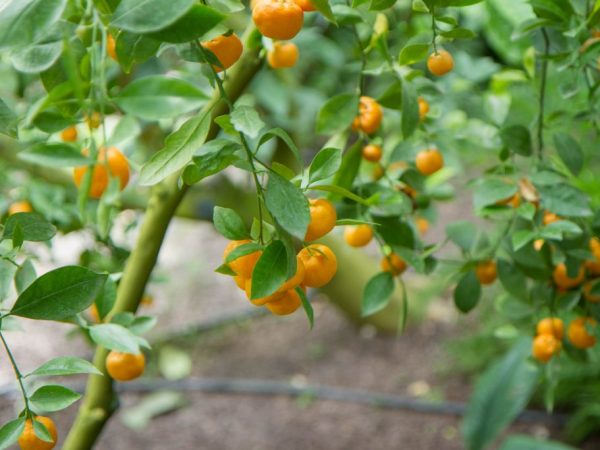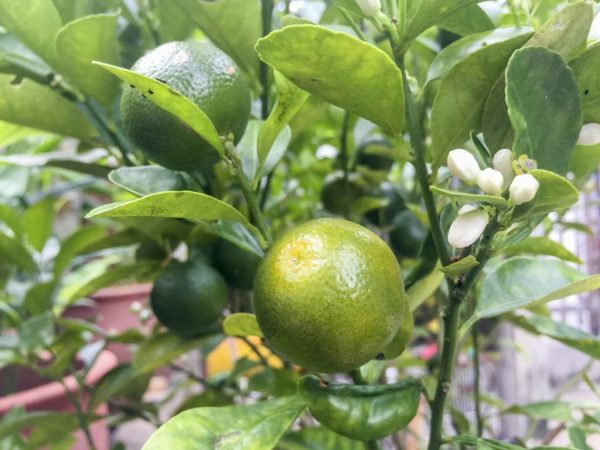Citrofortunella lemon
Citrofortunella lemon is an ornamental houseplant designed for successful cultivation at home.

Citrofortunella lemon
Botanical characteristic
Citrofortunella lemon belongs to the rutic family. The evergreen tree is the result of crossing a tangerine tree and fortunella (kumquat). A fast-growing, well-branching plant, compact in size, up to 1 m in height, small dark green foliage and a glossy surface with a pleasant citrus scent. Inflorescences are white, emitting a characteristic aroma.
Citrofortunella has another name - calamondin.
Fruits are small in size, 3.0-4.0 cm in diameter, weighing about 15-25 g, similar in appearance to tangerines, have a thin orange peel. The pulp of the fruit is too sour, with a bitter taste, and resembles kinkan in taste. There are a lot of seeds inside. In citrofortunella fruits, both the pulp and the skin are edible.
It is a self-pollinated plant with a high percentage of fruit set. The possibility of flowering occurs in 2-3 years, in the summer season, the fruiting stage - in the middle of winter. Simultaneous flowering and fruiting is not uncommon.
The life span of a plant is up to 5 years when grown at home and up to 20 years when grown in a natural environment.
Growing geography
The wild home of citrofortunella lemon is the continental and island territories located between China, India and Australia, including the Indo-Chinese peninsula and the Malay archipelago, as well as part of the Asia-Pacific region.
Recently, citrus has become widespread in home floriculture.
The chemical composition of the fruit
The chemical composition of citrofortunella contains:
- 0.88% proteins,
- 2.45% fat
- 3.29% carbohydrates.
The peel of the fruit contains calcium, ash substances, iron, phosphorus, ascorbic acid.
Calamondin fruits are widely used in cooking for the preparation of jams and preserves, as well as as a seasoning for meat dishes.
Varieties for home cultivation
A number of citrofortunella species are suitable for home floriculture:
- Peters are prized for their looks. This is a highly decorative plant.
- Tiger is a small-fruited variety that differs in foliage with a border or milky stripes.
- Shikinari stands out for its large fruit size and high taste.
- Variegatta is a variegated variety. At the initial stage of development, its fruits are colored with stripes; by full technical ripening, they acquire an even orange color.
Subtleties of care when growing
A feature of the variety is poor rooting of cuttings, therefore cultivation from seeds is rarely practiced due to the long period of plant development before flowering, therefore it is recommended to purchase grafted calamondin for planting at home.
Ornamental lemon citrofotunella at home grows profusely and bears fruit throughout the calendar year, subject to certain care rules.
Temperature regime

The plant tolerates heat and heat well.
The variety tolerates coolness and maintenance in warm conditions equally well. In the summer, it is recommended to take it out to the loggia. In winter, the optimum temperature is 14-16 ° C, but the plant is able to withstand a drop to 4 ° C.
Lighting
For full growth and the beginning of flowering, followed by fruiting, the lemon requires good lighting, using shading against direct sunlight.
Watering
Watering is necessary abundant. Excessive waterlogging of the soil mixture should not be allowed. The culture does not tolerate dry air, therefore it requires regular spraying with settled water with a temperature 2-3 ° C below room temperature.
Transfer
Lemon is transplanted into spacious potted containers using drainage. The suitable time for a transplant is March. The soil should consist of turf, rotted manure and river sand, mixed in proportions of 2: 1: 1/4.
Pruning
Pruning is carried out during the spring transplant process to give the ornamental plant a lush shape and ensure flowering. Summer care involves pruning only unnecessarily long branches.
Fertilizer
The introduction of fertilizing complexes falls on the main stages of flowering and fruiting, for which they use complex compositions for citrus fruits or mixtures with ammonium nitrate and potassium chloride, diluted in 1 liter of water, 5 g and 2 g, respectively.
In summer, the frequency of fertilization is once every 10 days, in winter - once every 30 days.
Root dressings alternate with foliar.
Reproduction
When grown at home, lemon is propagated by cuttings or by grafting:
- cuttings show the least efficiency, rooting occurs throughout the month in wet sand in containers covered with film or glass, followed by transplanting the cuttings into pot containers with a diameter of up to 15 cm,
- grafting refers to a faster way of reproduction, in the form of a rootstock, any citrus plant or a one-year-old seedling of the citrofortunella lemon itself is taken.
Conclusion
A hybrid of mandarin and kumquat, citrofortunella lemon has found widespread demand for home cultivation. The fruits contain a rich chemical composition and are edible. Subject to certain rules of care, the tree blooms and bears fruit outside its natural environment all year round.


